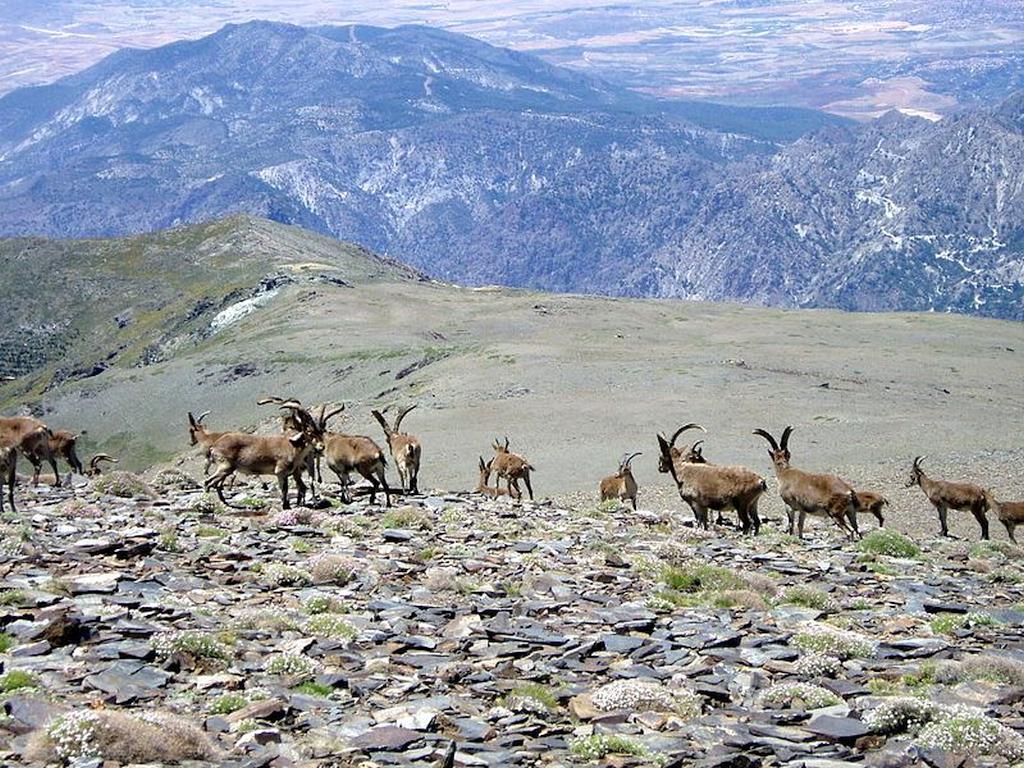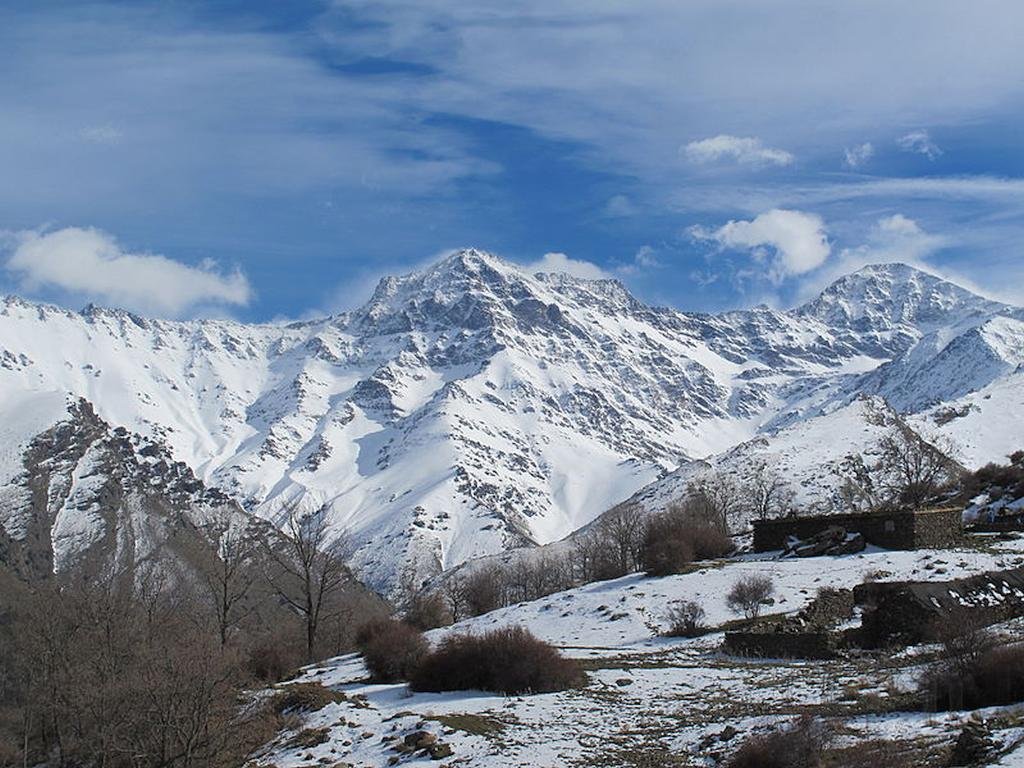The Sierra Nevada mountain range in Andalusia is a section of the Betic Cordillera and runs parallel to the Mediterranean sea for around 100km.
The temperature range is dramatic with the summits under snow for many months, followed by a hot Mediterranean style summer. This creates special microclimates across the exposed rocky summits, glacial lakes, sheer sided gorges, mixed oak woods, pine woods and fast rivers with wooded banks.
Declared a National Park in 1998 and encompassing an area of 86,208 hectares it is a popular destination throughout the year. It holds an exceptional variety of animal and plant life due to the combination of altitude and its proximity to the Mediterranean sea.
The area has also become famous as a starlight destination. The Starlight Foundation is a non-profit organization that was founded in 2009 to promote the protection of the night sky and the development of “astrotourism” and there is an ever growing list of starlight destinations in Spain to visit.
Find a hotel in the area
[booking_product_helper shortname=”trevelez”]
These mountains were formed during the Tertiary Period (65 to 1.8 million years ago), at the same point as the Atlas Mountains in Morocco and the European Alps. This mountain building event is called the Alpine Orogeny. The uplift happened as the African plate moved northwards colliding with the Eurasian plate. The Sierra Nevada mountains consist of mainly metamorphic rocks such as Gneiss and Mica schist. Many of the rocks are juxtaposed and mixed up due to intense faulting and folding during the compression of the two tectonic plates.
The parks lowest edge begins at 400m with the highest peaks situated to the western part of the sierras. They are Mulhacén 3,482m, Veleta 3,392m and Alcazaba 3,366m which are grouped together in a cluster. This mountain range is comparable with the Alps with more than 20 peaks over 3,000m, but in a southerly and warmer part of Europe. Mulhacén is the tallest summit in mainland Spain. (The highest overall peak belonginf to Spain being mount Teide in the Canary Islands.)
Flora
The Sierra Nevada and the Canary Islands have another similarity in that they carry the highest range of plant life in Spain. The Sierra Nevada holds a quarter of the plants listed in Spain, around 116 of which are threatened and 66 endemic, (solely from these mountains) having taken thousands of years to adapt in this difficult environment.
A few guided tours and activities in the Sierra Nevada mountain range in Andalusia
This is Europe’s most southerly glacial landscape where lichens are the most common vegetation, growing widely on the exposed and poor quality soils above 2,800m. The last of these glaciers melted at the end of the 20th century but there are around 50 glacial tarns, (lakes held in the depressions created by the glaciers) the highest one being the Laguna de Altera, at 3,146 m.
In the Sierra Nevada summits (above 2,000 meters) there are damp pastures which are covered in snow for a great part of the year. They represent one of the most fragile and exclusive ecosystems of the massif known in Spanish as “borreguiles“. They contain a great vegetal biodiversity and this is where most of the Nevada endemics can be found. The delicate balance for these plants is seriously threatened by the excessive grazing of livestock and these marshy grasslands and peat bogs will also alter with climate changes.
One of the more intriguing plants that grows on these humid grassland and watercourse edges above 2,000m is the carnivorous Pinguicula nevadensis. The lilac blue flowers in June or July are on stems that may only reach 10cm. This endemic “butterwort” has a sticky basal rosette of leaves onto which small insects get trapped. The leaves attract this extra food supply with their yellow colour and shiny substance. The victims get caught in the greasy coverage (mucilage) secreted by glands. Other glands are then stimulated to produce more digestive substances, suffocating and then breaking down the prey.
Some of the endemic plants of the sierra have reference to this in their names such as Verbascum nevadense, Saxifraga nevadensis, Arenaria nevadensis, Aquilegia vulgaris subsp. nevadensis or, they describe where they can be found, as in high glacial areas such as Linaria glacialis, Biscutella glacialis and Antirrhinum rupestre which grows in rock fissures.
On lower slopes are groves of oak trees dominated by the evergreen Holm oak (Quercus ilex) with Pyrenean oak (Q. pyrenaica) and Sweet chestnut (Castanea sativa) woodlands. There are tracts of pine trees (Pinus sylvestris) combined with Savin and Common junipers (Juniperus sabina, J. communis).
Hawthorn (Crataegus monogyna), Prickly juniper (Juniperus oxycedrus), Lentisc (Pistacia lentiscus), Wild olive trees (Olea europaea sylvestris), Mediterranean daphne (Daphne gnidium), Spanish barberry (Berberis hispanica) and Butcher’s broom (Ruscus aculeatus) also cloth the slopes.
Lower valleys have a deciduous mix of Gall oaks (Quercus faginea), Montpellier maple (Acer monspessulanum) and the native Maple (Acer granatense). The oak, chestnut and pine forests give way to the rolling hills of land cultivated with almond trees, citrus groves and vineyards
The river banks are lined with Poplar (Populus alba), Alder (Alnus glutinosa), Willow (Salix atrocinerea), Ash (Fraxinus angustifolia) and Elm (Ulmus minor). The Genil river valley is noteworthy for Mediterranean orchids and linarias (the source of which is in the high peaks).
Fauna
The easiest of the mammals to spot are the numerous Spanish ibex.

Other mammals which inhabit the area but are nocturnal or secretive and therefore more difficult to see include Wild boar, Fox, Badger, Wild cat, Weasel, Beech marten and Genet with the Garden dormice and Wood mouse (Apodemus sylvaticus) at the smaller end of the scale.
This is the southern most habitat for the Snow vole (Microtus nivalis). This vegetarian rodent lives on the scree slopes above the tree line. It is active both day and night and finds grasses to eat underneath the winter snow.
Birdlife
The birdlife is varied with species inhabiting different areas to suit their requirements. The higher points attracting Alpine accentor, Red-billed chough, Northern wheatear, Black redstart, Rock thrush and Rock bunting with Ring ouzel occasionally seen.
Birds of prey that can be seen soaring or hunting from the sky are Golden, Booted and Bonelli’s eagles, Peregrine falcon, Kestrel, Sparrowhawk, Goshawk and the largest, which often seen in large groups is the Griffon vulture.
The areas of Junipers are frequented by Linnet, Black-eared wheatear, Thekla lark, Crested lark, Ortolan bunting with Red-legged partridge hiding in the grassy areas.
Woodland areas contain birds such as Short-toed treecreeper, Iberian green woodpecker, Wood pigeon, Turtle dove, Coal tit, Great tit, Firecrest, Goldfinch, Jay, Hoopoe with Golden oriole and Wren plus a selection of warblers near the water courses.
Reptiles and Amphibians
The rivers contain trout and attract various amphibians and reptiles. The Betic midwife toad (Alytes dickhilleni) is on the Red List, marked as vulnerable. It is a species that is restricted to the mountains of southeastern Spain. Others include the Spanish painted frog (Discoglossus jeanneae), Fire salamander (Salamandra salamandra), Ocellated lizard (Timon lepidus nevadensis), Spiny-footed lizard (Acanthodactylus erythrurus) and Bedriaga’s skink (Chalcides bedriagai).
Butterflies
Sierra Nevada park has a list of some 120 butterfly species recorded with some endemic to the area such as the Sierra Nevada blue (Polyommatus golgus) which flies above 2,400m altitude and the large and easily identified Apollo (Parnassius apollo nevadensis) which only flies in mountainous areas.
Skiing in the Sierra Nevada
The resort of Prado Llano is at 2,100m on the slopes of Veleta. This is a base for winter skiing along with Sol y Nieve, a higher ski station. The track from here to the village of Capileira is the highest pass through the mountain and is closed to vehicles. This pass is popular with hikers but great care must be taken in crossing these mountains as with any summits of this altitude the weather can change quickly and ill equipped people can place themselves in great danger.
The highest villages in the Sierra Nevada
Capileira and Trevélez are two of the highest villages on the southern slopes of the Sierra Nevada. They are a part of the Alpujarras which is the name given to an area separated from the sea by a smaller mountain ridge, the Sierra de Contraviesa.
Granada
The nearby city of Granada is often the focus of a combined visit covering culture and nature. It holds the famous Palaces of the Alhambra within the Generalife gardens as well as a Cathedral and Monastery of La Cartuja.
Also in the area
El Jardín Botánico de la Cortijuela is a botanic garden which covers 12.4 hectares and is run by a Junta de Andalucía, and the University of Granada. It is in the area of Trevenque and aims to protect, conserve, propagate and investigate plants within the sierra concentrating on the endemics. Read more here: https://wildsideholidays.co.uk/hoya-de-pedraza-and-la-cortijuela-botanic-gardens/

Information/Visitors Centers:
In the western part of the park “El Dornajo” at Km 23 on the A395 road, with café, museum and library.
In the eastern part of the park “Láujar de Andarax” is on the C332 at Km 1.
Almost central to the park is the Puerto de la Ragua information point on the A337 at Km 11.6 by a picnic area of the same name.

In the Alpujarras there is an information point in the village of Pampaneira. and, don’t forget the Tourist offices in Granada and Almeria if you are in those areas.
Guided Activities
Spanish Highs
Walking, trekking, mountaineering, snow shoeing, ski touring, rock and snow adventures in the Sierra Nevada. Day or multi-day available with or without accommodation. Beginners, singles and groups welcome
More Information Here
SPANISH HIGHS, Sierra Nevada Mountain Guides

Looking for information about the natural and national parks in Andalucia? https://wildsideholidays.co.uk/natural-and-national-parks-in-andalucia/
Ronda Today
Everything you need to know before you visit Ronda “The city of dreams” in Andalucia. https://www.rondatoday.com/
Visit Cádiz
Planning on visiting Cádiz? Tourist information. Monuments. Hotels. Activities. City guides: https://visitingcadiz.com/
The Caminito del Rey
Find tickets for the Caminito del Rey: https://www.caminodelrey.es/
Wildside Holidays – Spain
Take a trip on the Wildside! Discover the wildlife and nature of Spain, its Natural and National Parks and find the top wildlife, activity and walking holiday companies.
Iberia Nature Forum
Struggling with identifying those bugs and beasties? Why not check out the Iberia nature Forum! https://iberianatureforum.com/
I’ve been living in this lovely area of Western Andalucia for the last 20 years or so and dedicate most of my time to the running of English language tourist information websites for the towns of Cádiz, Ronda, Grazalema, the famous or infamous Caminito del Rey, and also Wildside Holidays, which promotes sustainable and eco-friendly businesses running wildlife and walking holidays in Spain. My articles contain affiliate links that will help you reserve a hotel, bus, train or activity in the area. You don’t pay more, but by using them you do support this website. Thankyou!
